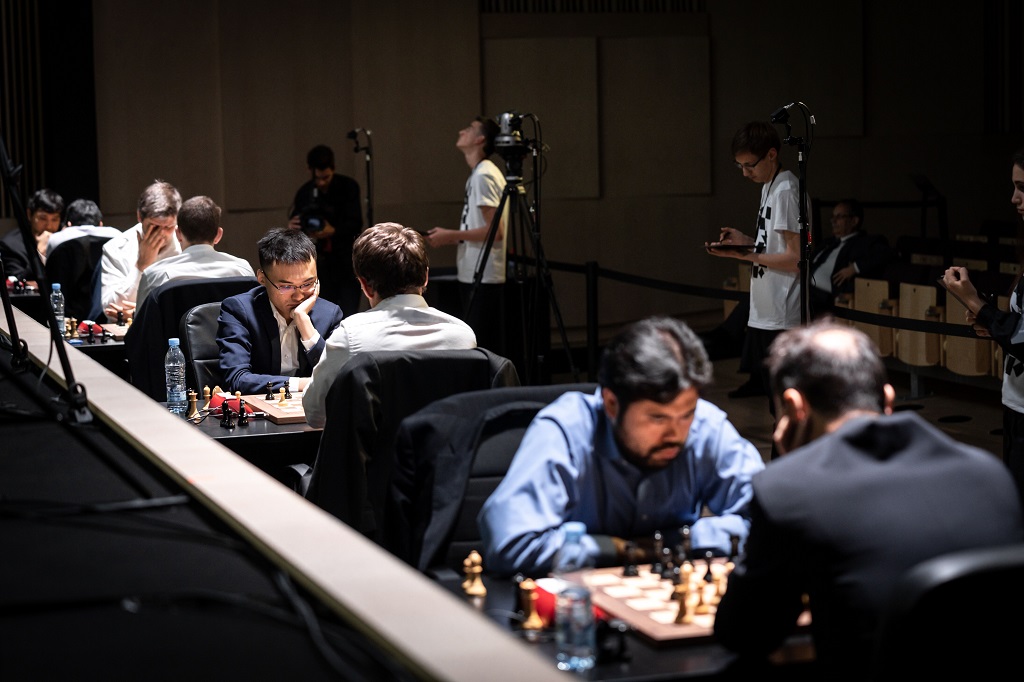


Not a single match-up of the fifteen played at the first leg of this year's Grand Prix in Moscow reached the sudden death phase, while in Riga we already saw two Armageddon games in round one. Sergey Karjakin mated Anish Giri with White on their seventh encounter of the day, while Yu Yangyi managed to draw Levon Aronian with Black to reach the quarter-finals.
The rest of the match-ups were decided in the rapid phase (25'+10" games) — Alexander Grischuk beat Nikita Vitiugov twice; Wesley So defeated Pentala Harikrishna in the first game and then held a draw with Black; while Veselin Topalov and Jan-Krzysztof Duda took down Hikaru Nakamura and Peter Svidler in their second encounters.
The pairings for the quarter-finals that begin Monday are Karjakin vs So, Duda vs Mamedyarov, Grischuk vs Yu Yangyi and Topalov vs Vachier-Lagrave.

Watching closely | Photo: Niki Riga / World Chess
Although Sergey Karjakin has dropped some rating points lately, he is known for being a fighter at heart, capable of withstanding a huge amount of pressure in critical situations. His rival, Anish Giri, arrived in Riga as the first seed, but for a second time in the Grand Prix was eliminated in round one. Apparently, the format does not suit him well — in fact, at this point he probably needs to think of other ways to qualify for the Candidates.
In the first rapid game, Karjakin had the white pieces and got a spatial advantage in the centre out of a Sicilian. Already under pressure, Giri gave up an exchange on move 28:
Black went for 28...♜xc5 but could not stop his rival's initiative. From then on, it was smooth sailing for Karjakin, who got the win after 46 moves.
Giri needed a win to stay alive, and he showed his class by defeating his Russian opponent in a fine positional effort. The Dutch grandmaster simplified into a rook endgame a pawn up, which he systematically converted with correct technique.
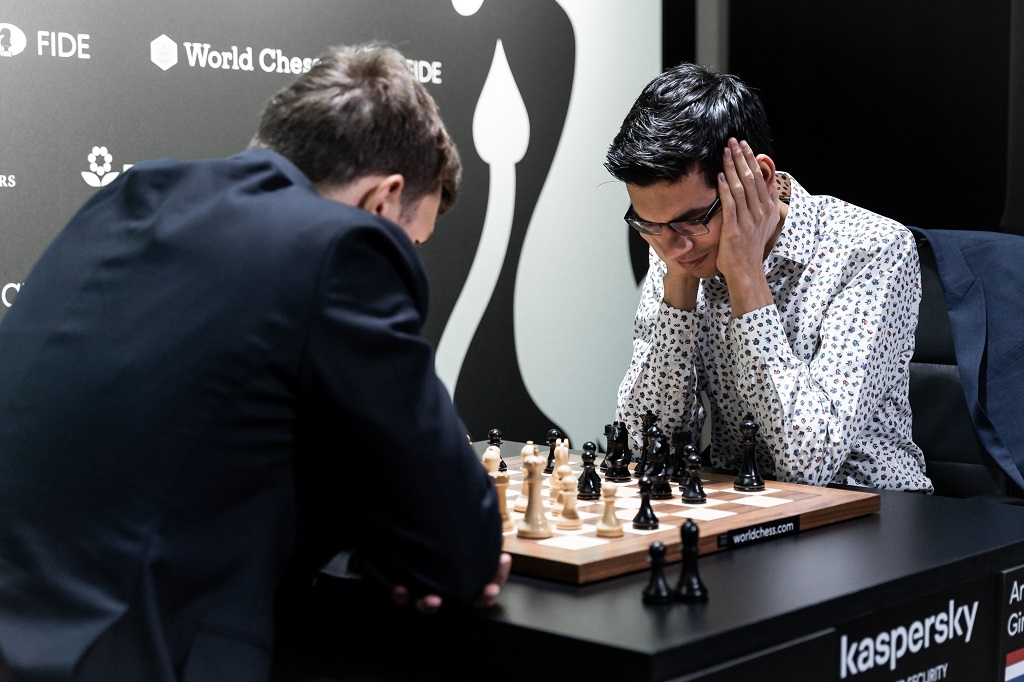
Anish Giri did not get to round two | Photo: Niki Riga / World Chess
Both 10'+10" encounters (ten minutes for the game, with ten-second increments from move one) finished drawn, as did both 5'+3" games. Karjakin was the one missing chances in the second encounter of the first set and Giri let some opportunites slip away in the last blitz game before Armageddon.
Karjakin had White in the sudden death game, which saw the players showing enterprising chess after six tense-filled battles. The critical factor in the end, however, was the vulnerability of Black's king. On move 30, White opened up more lines for his bishops with decisive effect:
White did not take long to mate the opposite king: 30.dxc6 ♞xc6 31.♕h4+ ♚g8 32.♗b3+ ♚f8 33.♕h8+ ♚e7 34.♗g5#. And Giri was out of contention in Latvia's capital.
Round 1 tiebreaks Interview with Sergey Karjakin | FIDE Chess YouTube
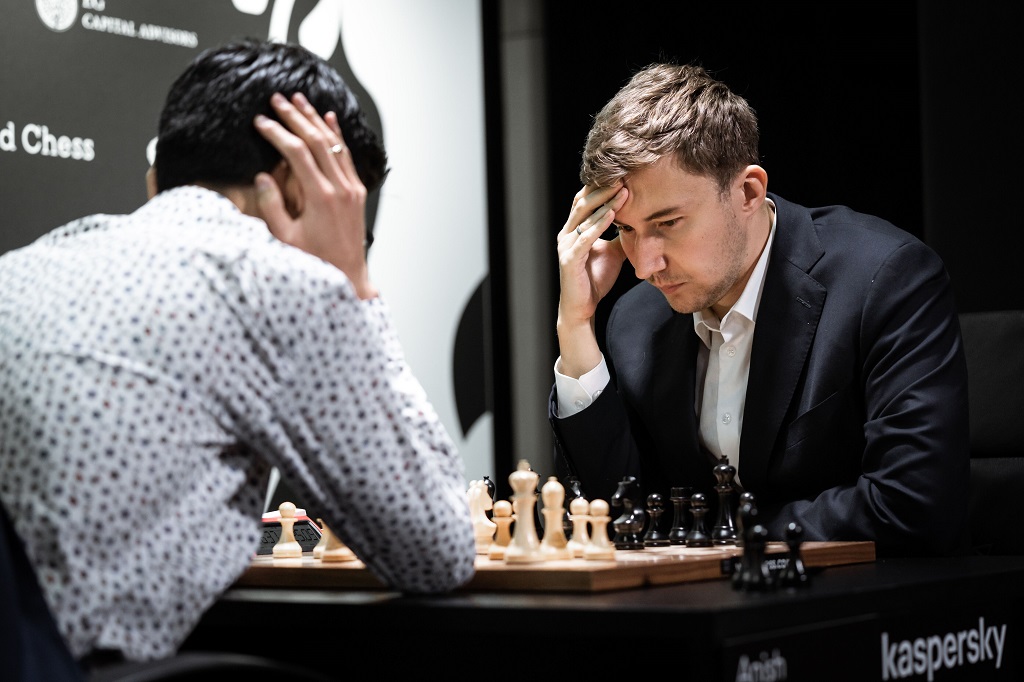
Former World Championship challenger Sergey Karjakin | Photo: Niki Riga / World Chess
Until game six (including the classical phase), this was clearly the least topsy-turvy match-up of round one, as Yu Yangyi and Levon Aronian showed good preparation and reluctance to take gratuitous risks. The first decisive result of the match was seen in the blitz section (5'+3"), when Aronian got a clean win with the white pieces.
Yu Yangyi bounced back with a win on demand. He had a rook and two pawns for Black's two pieces, but Aronian needed to find precise defensive moves to prevent the rook and queen duo from creating a mating attack. The Armenian faltered on move 38:
The Chinese grandmaster found the winning plan: 39.♖f8 ♛c1 40.♖f7 ♞f5 41.♕g6+ ♚g8 42.♖b7 and Black resigned a couple of moves later.
In the Armageddon, Yu Yangyi had the black pieces and, much like in the previous games of the match, he neutralized his opponent with pragmatic play. Aronian kept trying in a drawn bishop endgame until move 53, but the agreed draw meant Yu Yangyi got the ticket to next round.
Round 1 tiebreaks Interview with Yu Yangyi and Levon Aronian | FIDE Chess YouTube
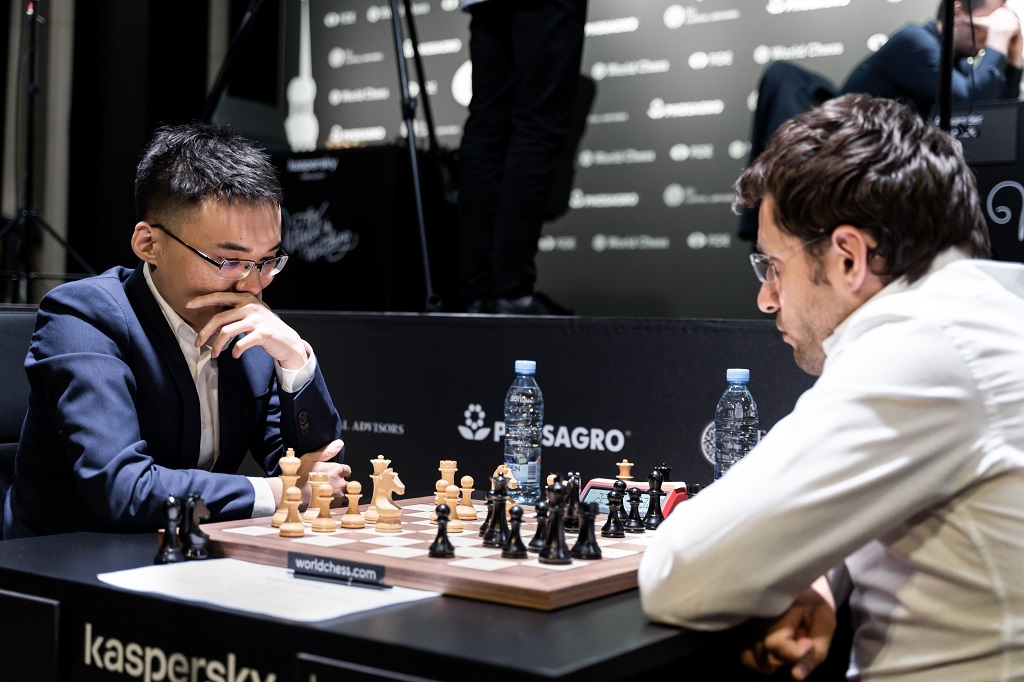
Yu Yangyi knocked out Levon Aronian | Photo: Niki Riga / World Chess
Jan-Krzysztof Duda was eliminated from the Moscow GP in the tiebreaks of the first round against Wesley So. After beating Peter Svidler in Riga, he admitted that he had gained some experience from that loss, which helped him face this challenge in a better frame of mind. On the other hand, Svidler confessed he felt the result was a fair portrayal of what had gone on in the match:
Jan-Krzysztof just played better the entire match, and he deserves to win, so I can't really have any complaints on that count.
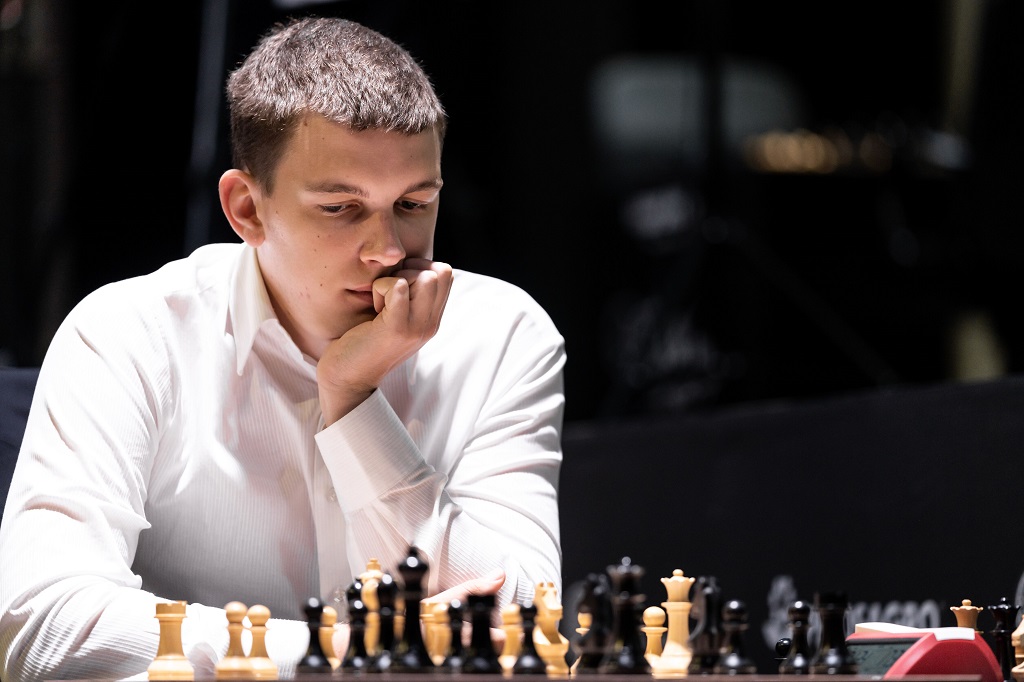
Polish grandmaster Jan-Krzysztof Duda | Photo: Niki Riga / World Chess
Duda played what he called a "computerish line" of the Petroff Defence in game one. He got a good position out of the opening and was on the better side of equality all throughout the game, which was a 68-move draw. The second rapid encounter saw Duda playing actively with the pair of bishops. Svidler was defending well in a dynamic struggle, but eventually his opponent gained a pawn and converted it into a win after 69 moves.
Round 1 tiebreaks Interview with Svidler and Duda | FIDE Chess YouTube
This very balanced match-up was decided on the first rapid encounter, when Wesley So showed great calculation abilities to overpower his Indian opponent after no less than 89 moves. Harikrishna had an uncomfortable position out of the opening but never stopped finding defensive resources. The players went into an endgame with rook, bishop and knight against a queen, with White trying to prevent his opponent from finding a perpetual (like he had done in the first game of the match) — So did manage to do it this time and got the all-important win.
In game two, the American grandmaster played pragmatically, and Harikrishna could not create enough winning opportunities to upset the balance. The draw was signed in a rook endgame in which Black was a pawn to the good.
Round 1 Tiebreaks Interview with Harikrishna & So | FIDE Chess YouTube
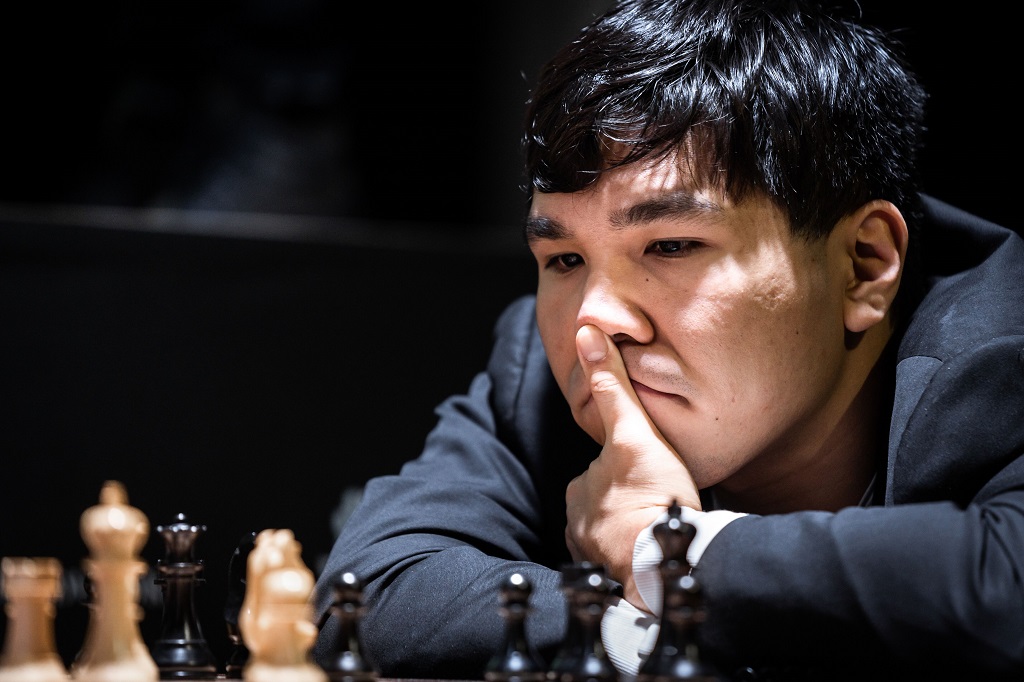
Wesley So is world's number four in the live ratings list | Photo: Niki Riga / World Chess
Hikaru Nakamura's woes continue after his substandard performance in Croatia, as he was the favourite in the rapid but could not prevent former world champion Veselin Topalov from taking him out of the Riga Grand Prix. The current US champion was asked about having to play two first-class events back-to-back, and he responded:
There are many things I could say in regards to the schedule issue, but [...] everyone has to deal with it, so we'll see who survives at the end.
Topalov had no problems holding the first tiebreak game with Black and then went on to take advantage of Nakamura's inaccuracies in an endgame with two minor pieces per side in game two. The Bulgarian will face Vachier-Lagrave in the next round and this is what he had to say about it:
I just didn't really expect to pass the first round, so it's already a big success for me. So I just don't care that much.
Round 1 Tiebreaks Interview with Nakamura & Topalov | FIDE Chess YouTube

Veselin Topalov talking to the press | Photo: Niki Riga / World Chess
The runner-up of the Moscow leg, Alexander Grischuk, is already looking like a favourite in the Grand Prix, as he took down Nikita Vitiugov with two wins in the rapid section of their match-up. Grischuk had the white pieces in the first encounter and, after his rival blundered by castling kingside, he finished the game with a flourish:
There is no way to stop White's attack — there followed 20.♗f6 ♝d8 21.♗xg7 ♚xg7 22.♖g3+ ♚h8 23.♕h5 and Black resigned.
Vitiugov lost a couple of pawns after erring again in game two, which provoked him to resign after merely 24 moves.
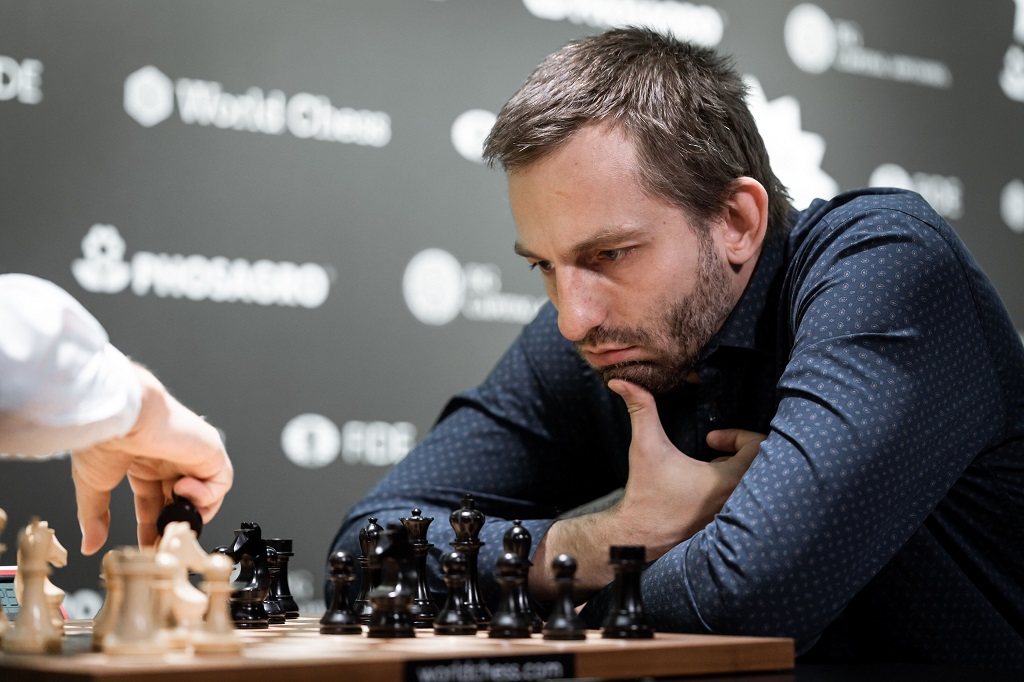
Alexander Grischuk | Photo: Niki Riga / World Chess
Commentary by GMs Evgeny Miroshnichenko and Arturs Neikans